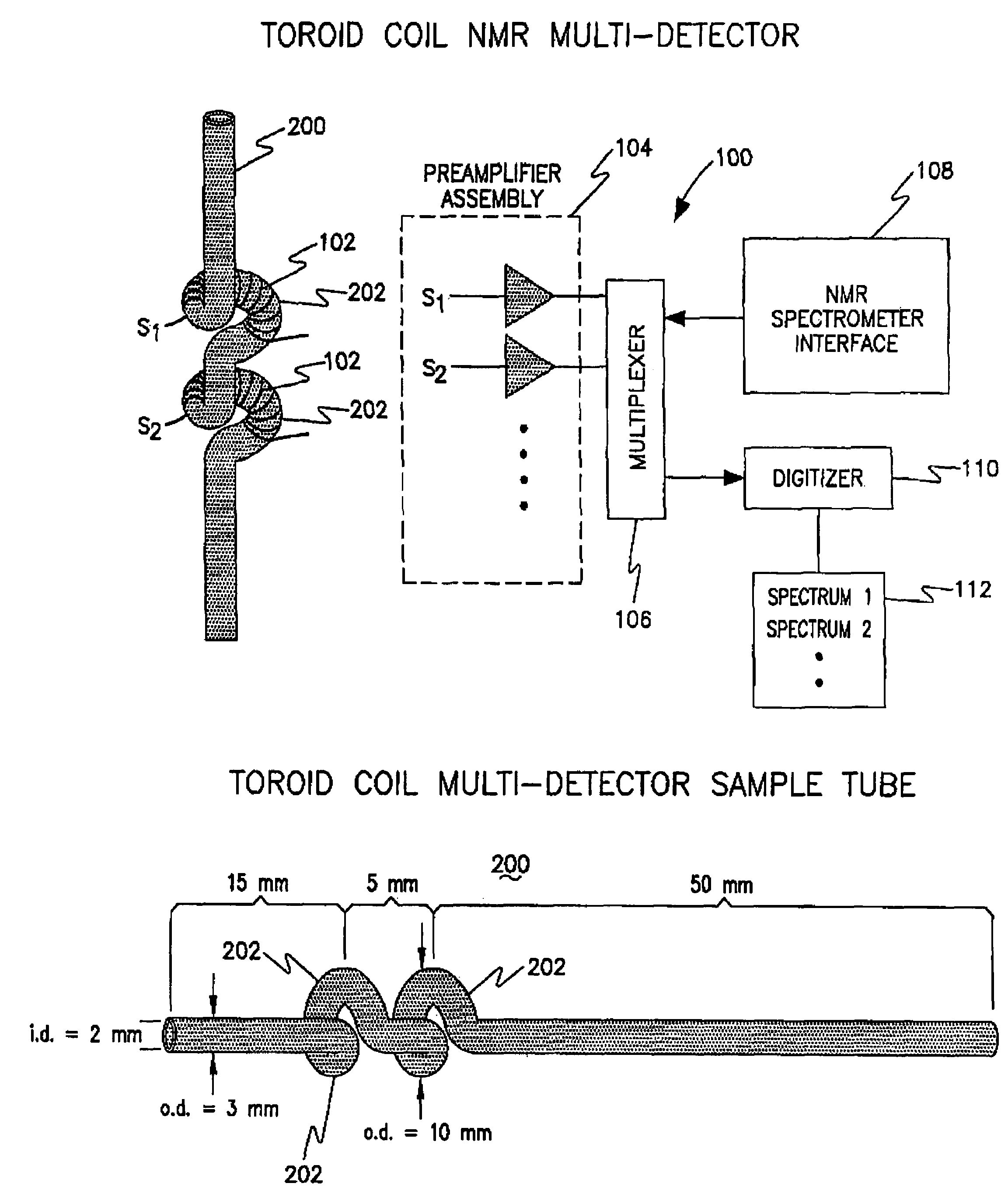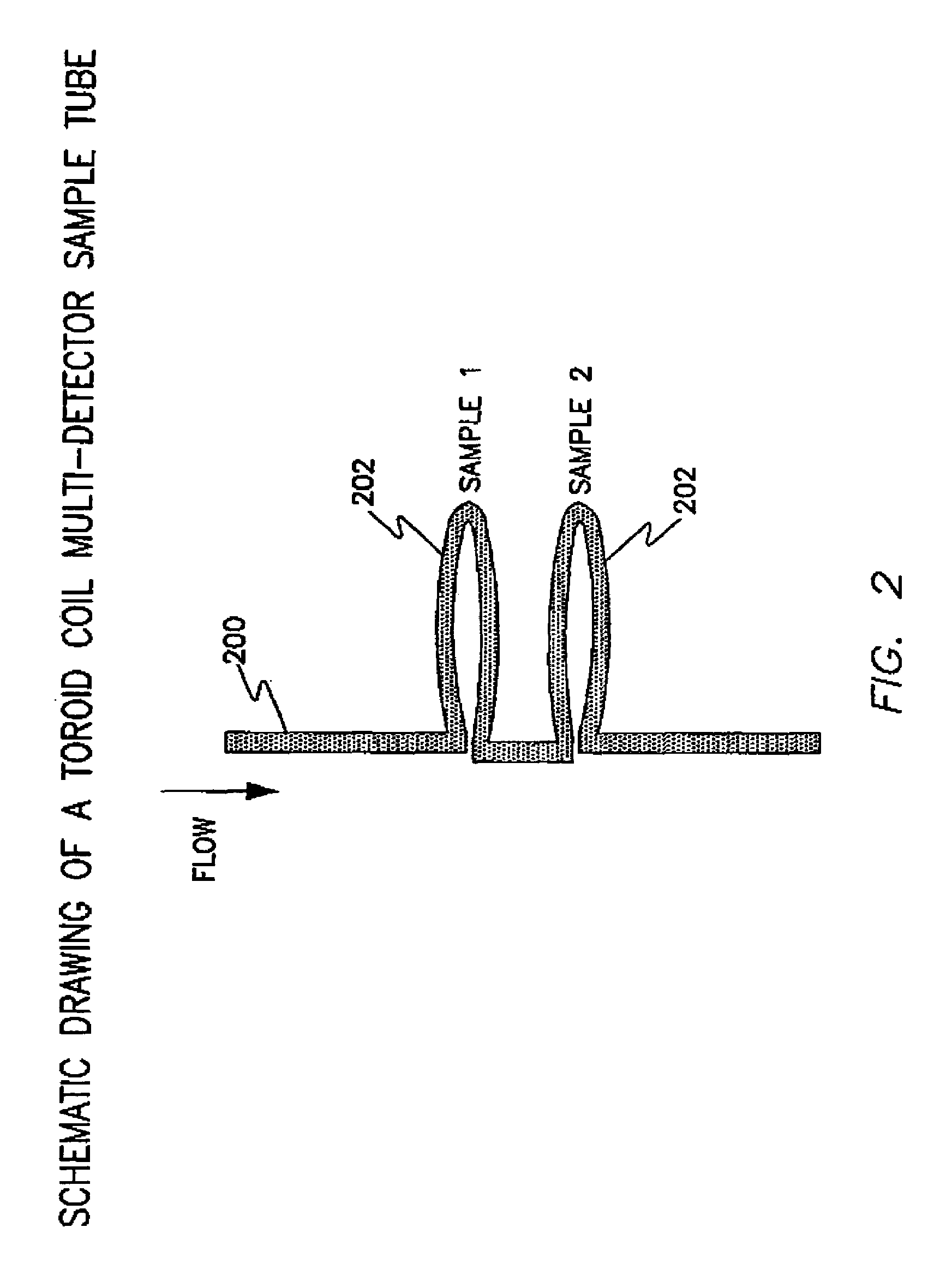Toroid cavity/coil NMR multi-detector
a multi-detector, toroid cavity technology, applied in the direction of magnetic measurement, measurement device, instruments, etc., can solve the problems of reducing the quality factor of the resonant circuit, contaminated nmr spectra, and the dipolar fringe field of the solenoid coil, so as to eliminate the homogeneity of the magnetic field, the effect of spreading the linewidth of the nmr resonance and rapid, non-invasive nuclear magnetic resonan
- Summary
- Abstract
- Description
- Claims
- Application Information
AI Technical Summary
Benefits of technology
Problems solved by technology
Method used
Image
Examples
first embodiment
[0039]In accordance with features of the invention, a protocol that was developed for testing multi-detector NMR probes composed of n coils consists of collecting a nutation image (a volume-weighted map of the magnitude of the RF magnetic field over the entire sample volume) for every permutation of transmitter (TR) coupling (sample excitation), receiver (RV) coupling (signal reception), and all n coils. If a numeral subscript is used to designate a coil, then the series for the test protocol is: TR1RV1, TR1RV2, . . . TR1RVn, TR2RV1, TR2RV2, TR2RVn, . . . TRnRVn. Nutation images (also know as rotating frame images) were recorded using the present invention following this protocol.
[0040]Having reference now to the drawings, FIGS. 1 and 4 illustrate a NMR multi-detector of the preferred embodiment generally designated by the reference character 100 employing a plurality of toroid coils 102 coupled by a preamplifier assembly 104 to a signal multiplexer 106. An NMR spectrometer interfac...
second embodiment
[0051]FIGS. 11A, 11B, 11C, 11D, and 11E illustrate an NMR multi-detector generally designated by reference character 1100 employing a combination of a plurality of Helmholtz coils 1102 and a toroid cavity 1104, a preamplifier assembly 1106, and a signal multiplexer 1108. An INOVA interface 1110 manufactured by Varian Inc. of Palo Alto, Calif., and a digitizer 1112 are coupled to the signal multiplexer 1108. A spectrum 1-n, 1114 or experiment image is generated corresponding to each preamplified signal S1-Sn input to the signal multiplexer 1108. A toroid cavity RF circuit 1120 coupled to a central conductor 1122 is used to simultaneously excite all samples, whereas the individual Helmholtz coils 1102, which are too delicate for the high current of the RF excitation pulse and supported by non-conductive (e.g., glass) tubes 1130, independently detect the weak NMR signals from a corresponding capillary sample tube 1116. The B1 field direction of each Helmholtz coil 1102 is oriented perp...
third embodiment
[0055]FIGS. 12A and 12B illustrate a multi-detector NMR probe generally designated by reference character 1200 based on a toroid detector of the preferred embodiment. FIG. 12A illustrates a plurality of samples or three samples S1, S2, and S3 within a sample holder 1202 that are provided at different radial positions from a central conductor 1204 within a toroid cavity 1206 shown in FIG. 12A. The sample holder 1202 includes a plurality of concentric sample loops 1210, 1212, and 1214 connected with connector 1215 as shown in FIG. 12A. The radial positions of three samples S1, S2, and S3 are determined such that an NMR signal is obtained selectively from each sample loop by a series of appropriately calibrated RF pulses in a pseudo or partial rotating frame image, for example, employing equal or unequal pulse width increments. Alternatively, a second parallel set of a plurality of sample tubes 1216, 1218, and 1220 may be arranged as shown. This parallel set of tubes would each be prov...
PUM
 Login to View More
Login to View More Abstract
Description
Claims
Application Information
 Login to View More
Login to View More - R&D
- Intellectual Property
- Life Sciences
- Materials
- Tech Scout
- Unparalleled Data Quality
- Higher Quality Content
- 60% Fewer Hallucinations
Browse by: Latest US Patents, China's latest patents, Technical Efficacy Thesaurus, Application Domain, Technology Topic, Popular Technical Reports.
© 2025 PatSnap. All rights reserved.Legal|Privacy policy|Modern Slavery Act Transparency Statement|Sitemap|About US| Contact US: help@patsnap.com



